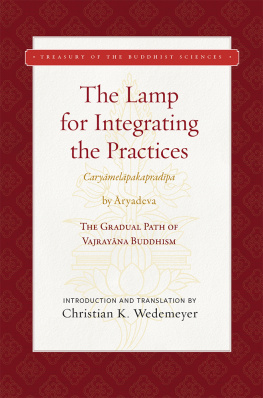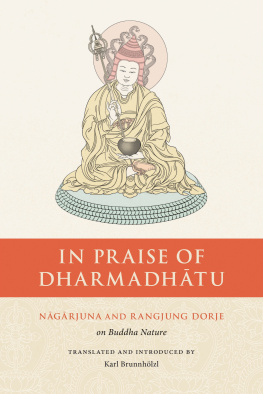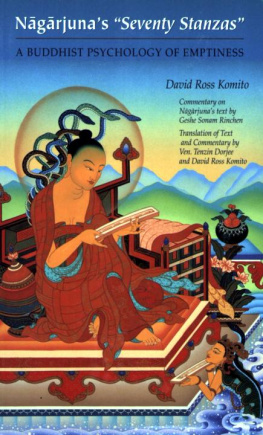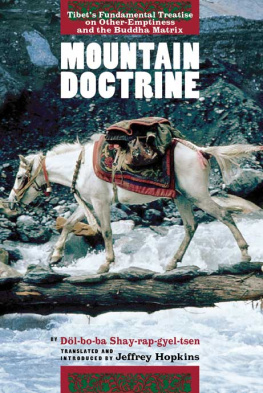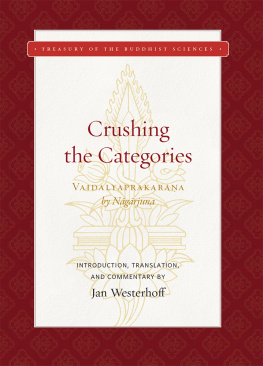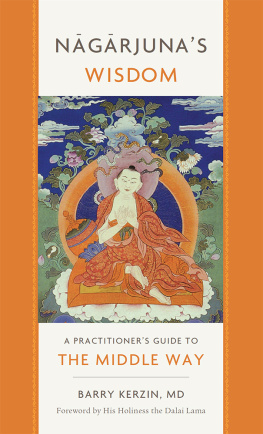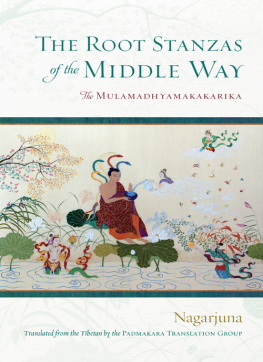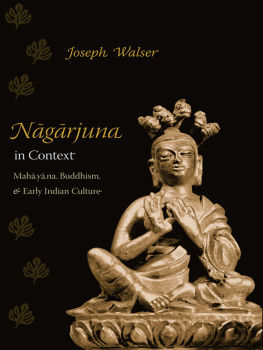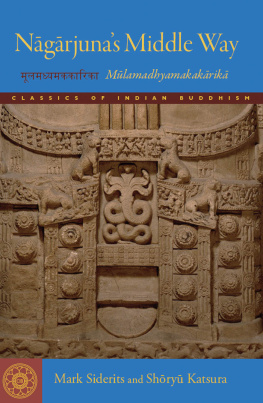

with Commentary
by Gyeltsap
This book has been approved for inclusion in the series Textual Studies and Translations in Indo-Tibetan Buddhism. The editorial board for this series includes:Roger JacksonCarleton CollegeAnne KleinRice UniversityKaren LangUniversity of VirginiaJohn StrongBates College
Aryadeva's
Four Hundred Stanzas
on the Middle Way
with Commentary
by Gyel-tsap
Aryadeva and Gyel-tsap
translated by Ruth Sonam with additional commentary by Geshe Sonam Rinchen

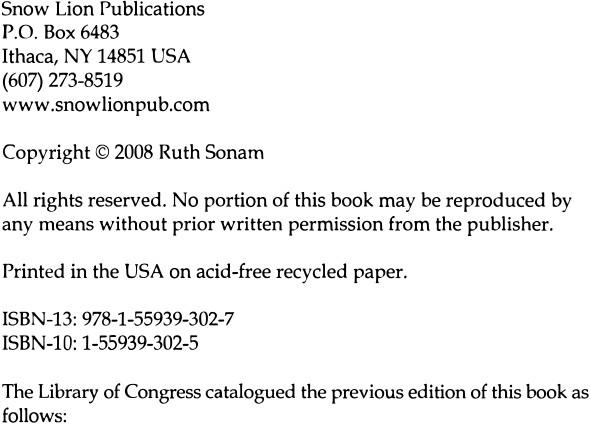
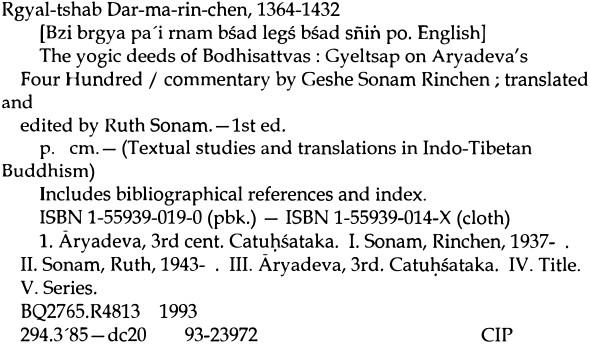
Contents
......................................................................................... 7
............................................................................. 51
................................................................................... 53
GYEL-TSAP'S COMMENTARY ON THE FOUR HUNDRED STANZAS
.............................................................................................. 57
................................................................................................ 59
......................................... 65
............................................... 83
.......................................... 101
.................................................................. 117
.................................................................. 133
....................................... 151
......................... 169
...................................... 185
..................... 203
.................................... 215
................................................ 227
........................................................... 239
........... 251
............................................ 265
................................ 277
........................... 289
................................................................................. 301
......................................... 305
................................................................................................. 331
................................................................................................. 389
Introduction
MADHYAMIKA AND ITS IMPLICATIONS
Madhyamika philosophy, based on the Buddha's Perfection of Wisdom Sutras, was expounded by the great Indian master Nagarjuna and by Aryadeva, Buddhapalita, Bhavaviveka and Candrakirti who followed him. It calls into question the very basis of our perceptions and conceptual framework and challenges us to become listeners and observers in the truest sense. To examine reality and what underlies it demands openness, which the great Madhyamika masters stress as an indispensable prerequisite for successful development. Because the principles of Madhyamika contradict our normal conceptions, we need courage to engage in the honest and rigorous investigation of reality that it advocates and to integrate the far-reaching implications of what is discovered into our lives.Madhyamika is a philosophy of the middle way between two impossible extremes, that of reified existence and that of total non-existence, neither of which describes the true status of phenomena. Though the term "reified existence" is used to refer to a whole range of impossible modes of existence that preclude dependence, in general it implies objective existence independent of the observer's participation. "Non-existence" refers to the lack of any kind of valid status that can be ascertained. Statements, made by the Buddha and frequently repeated by the great Buddhist masters, that things are "like dreams and illusions" are often misinterpreted and taken to mean that things do not exist. Madhyamika philosophy demonstrates through the use of reasoning that though things do not exist independently and concretely as they seem to do, they nevertheless exist: their mode of existence is a dependent one. Madhyamika philosophy extensively investigates the nature of this dependence.The purpose of Madhyamika is not to outwit opponents nor to enhance intellectual agility in what at times might seem like a philo sophical balancing act. Its true and only purpose is to help us gain happiness and freedom.The Buddha taught that ignorance lies at the root of our difficulties and suffering. This ignorance is not merely a lack of understanding but a misconception of how things exist and, most importantly, of how the self exists. Although the self is merely attributed to the combination of body and mind, our misconception fabricates a self which is an exaggeration of what actually exists. We cling to this and seek the kind of friends, possessions and surroundings that we imagine will ensure the happiness of this fabricated self. Anything that acts as an obstacle becomes a source of frustration. We suffer because we are buffeted by desire and anger and experience the effects of the actions we perform under the influence of these turbulent emotions. We fail to find the peace, success and security we seek and instead encounter difficulties and disappointments. This pattern keeps repeating. Through a correct understanding of reality we can eventually gain freedom from this suffering by ridding ourselves of the misconception which lies at its root.The quest for this understanding involves us in an enquiry to determine the criteria for existence and in an investigation of how we perceive reality. These two are connected since, from a Buddhist point of view, something can be said to exist only if it is validated or certified by cognition. What we see depends on how we look. Conventional and ultimate truths are thus established in relation to the kind of awareness which investigates them.Following the guidelines provided by the Madhyamika masters we come to recognize that our apprehension of objects as isolated and independent does not accord with how things actually are. An underlying network of interdependence connects phenomena. This does not mean that all phenomena are mutually dependent parts of a greater whole, such as is posited in the current "Gaia hypothesis," for instance, which views that whole as a living conscious organism. In Madhyamika, interdependence refers to the fact that everything existent depends on its parts, on imputation by thought, and in the case of impermanent things, also on causes and conditions. Recognition of this extends and alters our understanding, and can eventually lead to a fundamental transformation of perception and experience.Contemporary literature reflecting the discoveries made in new physics expresses and examines the need for a world-view based on a radically different paradigm. Responsibility for the present dilem mas which face the world is often attributed to the fragmented and reductive world-view fostered by what is now commonly referred to as the Cartesian-Newtonian paradigm. From that perspective the root of our problems would only be a few centuries old. From a Buddhist standpoint, however, the misconception that things exist in and of themselves is not just an intellectual habit acquired through education and social conditioning but has been present throughout all our rebirths. Things appear to exist from their own side and we instinctively assent to this deceptive appearance. All living beings who have not understood the nature of reality respond in this way. The misconception is thus an unconscious habit of which we can rid ourselves only by first becoming aware of how it operates. It is so deeply engrained that even when it itself has been eradicated, the imprints it leaves cause the false appearance of objective existence to persist until one becomes completely enlightened.Reality is multilayered and multifaceted in that everything existent has a complex conventional nature as well as a fundamental nature. At present we not only distort and are unaware of this fundamental nature but also distort conventional reality. To understand the fundamental or ultimate nature of things it is first necessary to gain a correct understanding of their conventional nature. The extent to which we habitually distort this can be measured by our discomfort when confronted by a description of the conventional, denuded of all unrealistic expectations and fantasies. We react with resistance because our attitudes and life-style seem threatened, since much that we do is based on mistaken assumptions: that we will live long, that our bodies are clean and innately pleasurable and that there is a very real and independent self which must be protected and satisfied.Even though in daily life we can of course practise altruism and restraint from harmful activity, which are the essence of the Buddha's teaching, his recommendations stand in sharp contrast to the generally accepted values and norms of most societies. While the prevalent economic stance fosters continual growth, greed and consumption, the way of life advocated by the Buddha, which is both conducive to and a natural outcome of spiritual growth, is opposed to materialism, inequity and exploitation of all kinds. In fact the Buddha's teaching addresses the very issues which are essential to the survival of our world and its inhabitants-the need for non-violent and sustainable life-styles based on respect and concern for life and on the cultivation of contentment.The ultimate and conventional are intimately connected, since from a philosophical point of view the two truths are considered to be one entity and different aspects of reality. A correct understanding of both conventional and ultimate reality will have profound practical and ethical implications. Our misconception of the self lies at the root of our selfishness, the main obstacle which prevents us from developing genuine altruism. Understanding the true nature of the self and recognizing how much others suffer because of their misconception of it can enhance our compassion toward them. This then inevitably finds expression in our physical and verbal activities. A genuine concern for the happiness of other living beings will naturally include concern for the well-being of the environment in which they live. In Buddhist teaching these two are referred to as the "contents and the container," thereby stressing their close connection. Recognition that events depend on a constellation of causes and conditions, that our perception of events is not necessarily reliable and that our own and others' negative behavior is underlain by confusion and disturbing emotions can help us to become more flexible and more capable of resolving conflict.The Madhyamika point of view that nothing whatsoever has true or independent existence has an extremely optimistic dimension. The disturbing attitudes and emotions which at present dominate our mind and behavior are entirely dependent on causes and conditions of which the internal are most influential. This means we can transform our attitudes and emotional responses by learning to create the specific causes and conditions from which positive and beneficial states of mind and feelings arise. We can therefore enhance the quality of life on our planet in as far as we, the individuals who inhabit it, each accept our role in creating such a change and are willing to undertake a personal transformation which can only come about through conscious effort.
Next page


